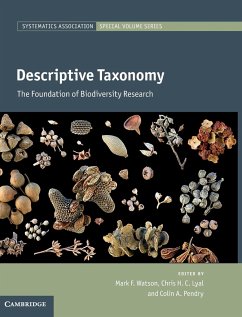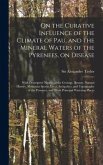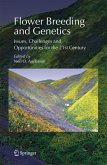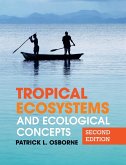Descriptive Taxonomy
Herausgeber: Watson, Mark F.; Pendry, Colin; Lyal, Chris
Descriptive Taxonomy
Herausgeber: Watson, Mark F.; Pendry, Colin; Lyal, Chris
- Gebundenes Buch
- Merkliste
- Auf die Merkliste
- Bewerten Bewerten
- Teilen
- Produkt teilen
- Produkterinnerung
- Produkterinnerung
Taking a multidisciplinary approach, this book explores how new technologies are facilitating more effective collection and dissemination of taxonomic data.
Andere Kunden interessierten sich auch für
![Alpine Ecosystems in the Northwest Caucasus Alpine Ecosystems in the Northwest Caucasus]() Vladimir G. Onipchenko (Hrsg.)Alpine Ecosystems in the Northwest Caucasus219,99 €
Vladimir G. Onipchenko (Hrsg.)Alpine Ecosystems in the Northwest Caucasus219,99 €![Marine Algae Marine Algae]() Marine Algae226,99 €
Marine Algae226,99 €![On the Curative Influence of the Climate of Pau, and the Mineral Waters of the Pyrenees, on Disease: With Descriptive Notices of the Geology, Botany, On the Curative Influence of the Climate of Pau, and the Mineral Waters of the Pyrenees, on Disease: With Descriptive Notices of the Geology, Botany,]() On the Curative Influence of the Climate of Pau, and the Mineral Waters of the Pyrenees, on Disease: With Descriptive Notices of the Geology, Botany,37,99 €
On the Curative Influence of the Climate of Pau, and the Mineral Waters of the Pyrenees, on Disease: With Descriptive Notices of the Geology, Botany,37,99 €![The Spas of Belgium, Germany, Switzerland, France, and Italy: a Hand-book of the Principal Watering Places on the Continent: Descriptive of Their Natu The Spas of Belgium, Germany, Switzerland, France, and Italy: a Hand-book of the Principal Watering Places on the Continent: Descriptive of Their Natu]() Thomas More MaddenThe Spas of Belgium, Germany, Switzerland, France, and Italy: a Hand-book of the Principal Watering Places on the Continent: Descriptive of Their Natu39,99 €
Thomas More MaddenThe Spas of Belgium, Germany, Switzerland, France, and Italy: a Hand-book of the Principal Watering Places on the Continent: Descriptive of Their Natu39,99 €![Flower Breeding and Genetics Flower Breeding and Genetics]() Neil O. Anderson (ed.)Flower Breeding and Genetics229,99 €
Neil O. Anderson (ed.)Flower Breeding and Genetics229,99 €![Biodiversity and Evolutionary Ecology of Extinct Organisms Biodiversity and Evolutionary Ecology of Extinct Organisms]() Rituparna BoseBiodiversity and Evolutionary Ecology of Extinct Organisms75,99 €
Rituparna BoseBiodiversity and Evolutionary Ecology of Extinct Organisms75,99 €![Tropical Ecosystems and Ecological Concepts Tropical Ecosystems and Ecological Concepts]() Patrick L. OsborneTropical Ecosystems and Ecological Concepts77,99 €
Patrick L. OsborneTropical Ecosystems and Ecological Concepts77,99 €-
-
-
Taking a multidisciplinary approach, this book explores how new technologies are facilitating more effective collection and dissemination of taxonomic data.
Hinweis: Dieser Artikel kann nur an eine deutsche Lieferadresse ausgeliefert werden.
Hinweis: Dieser Artikel kann nur an eine deutsche Lieferadresse ausgeliefert werden.
Produktdetails
- Produktdetails
- Verlag: Cambridge University Press
- Seitenzahl: 350
- Erscheinungstermin: 8. Januar 2015
- Englisch
- Abmessung: 260mm x 208mm x 23mm
- Gewicht: 973g
- ISBN-13: 9780521761079
- ISBN-10: 0521761077
- Artikelnr.: 41882801
- Herstellerkennzeichnung
- Libri GmbH
- Europaallee 1
- 36244 Bad Hersfeld
- gpsr@libri.de
- Verlag: Cambridge University Press
- Seitenzahl: 350
- Erscheinungstermin: 8. Januar 2015
- Englisch
- Abmessung: 260mm x 208mm x 23mm
- Gewicht: 973g
- ISBN-13: 9780521761079
- ISBN-10: 0521761077
- Artikelnr.: 41882801
- Herstellerkennzeichnung
- Libri GmbH
- Europaallee 1
- 36244 Bad Hersfeld
- gpsr@libri.de
List of contributors; Introduction M. F. Watson and C. Lyal; Part I. The
Widening Audience: 1. Floras yesterday, today and tomorrow A. G. Miller, M.
Hall, M. F. Watson, S. G. Knees, C. Pendry and M. R. Pullan; 2. Current
uses and future perspectives for conservation biology B. Collen; 3. The
present and future value of Floras for functional ecologists J. Dick, R.
Smith and R. Wadsworth; 4. A publisher's perspective: making biodiversity
information available and relevant to a wide audience J. Connor; Part II.
The Products of Descriptive Taxonomy: 5. Lessons learned from two projects,
the Fauna Europaea and the Checklist delle specie della fauna italiana A.
Minelli; 6. Flora Europaea and Euro+Med S. L. Jury; 7. Increasing the
utility of the regional African Floras D. W. Kirkup, P. Malcolm and A.
Paton; 8. Cybertruffle: an on-line resource for mycology D. W. Minter; 9.
Zooplankton Identification Manual for North European Seas (ZIMNES) L. C.
Hastie; 10. A field guide to the dragonflies and damselflies of Britain and
Ireland S. J. Brooks; 11. Sangha Trees: an identification and training
guide to the trees of the northern Republic of Congo A. H. Wortley and D.
J. Harris; 12. Millennium Seed Bank collector guides D. Hopkins; 13.
Training in tropical plant identification D. J. Harris, S. Bridgewater and
J.-M. Moutsamboté; 14. Field identification of vectors and pathogens of
military significance A. G. Gutierrez; Part III. The Influence of
Technology on Data Gathering in the Field: 15. The changing role of
collections and field research S. Knapp; 16. Field methods for inventorying
insects C. L. Häuser and K. Riede; 17. From seabed to world wide web: an
overview of marine zoological sampling, data processing and potential
production of digital marine faunas A. L. Allcock and M. Ryan; 18.
Advancements in electronic data capture for botanical field research in
temperate regions M. F. Watson, A. G. Miller, M. R. Pullan, C. Pendry and
S. G. Knees; Part IV. New Technologies: Their Current Use and Future
Potential: 19. Extending floras and faunas to include users' views A. L.
Weitzman and C. Lyal; 20. Taxa, taxon names and globally unique identifiers
in perspective R. Hyam; 21. E-publishing descriptive taxonomy: the
convergence of taxonomic journals and databases V. S. Smith; 22. DNA
barcoding in floral and faunal research S. E. Miller; Index.
Widening Audience: 1. Floras yesterday, today and tomorrow A. G. Miller, M.
Hall, M. F. Watson, S. G. Knees, C. Pendry and M. R. Pullan; 2. Current
uses and future perspectives for conservation biology B. Collen; 3. The
present and future value of Floras for functional ecologists J. Dick, R.
Smith and R. Wadsworth; 4. A publisher's perspective: making biodiversity
information available and relevant to a wide audience J. Connor; Part II.
The Products of Descriptive Taxonomy: 5. Lessons learned from two projects,
the Fauna Europaea and the Checklist delle specie della fauna italiana A.
Minelli; 6. Flora Europaea and Euro+Med S. L. Jury; 7. Increasing the
utility of the regional African Floras D. W. Kirkup, P. Malcolm and A.
Paton; 8. Cybertruffle: an on-line resource for mycology D. W. Minter; 9.
Zooplankton Identification Manual for North European Seas (ZIMNES) L. C.
Hastie; 10. A field guide to the dragonflies and damselflies of Britain and
Ireland S. J. Brooks; 11. Sangha Trees: an identification and training
guide to the trees of the northern Republic of Congo A. H. Wortley and D.
J. Harris; 12. Millennium Seed Bank collector guides D. Hopkins; 13.
Training in tropical plant identification D. J. Harris, S. Bridgewater and
J.-M. Moutsamboté; 14. Field identification of vectors and pathogens of
military significance A. G. Gutierrez; Part III. The Influence of
Technology on Data Gathering in the Field: 15. The changing role of
collections and field research S. Knapp; 16. Field methods for inventorying
insects C. L. Häuser and K. Riede; 17. From seabed to world wide web: an
overview of marine zoological sampling, data processing and potential
production of digital marine faunas A. L. Allcock and M. Ryan; 18.
Advancements in electronic data capture for botanical field research in
temperate regions M. F. Watson, A. G. Miller, M. R. Pullan, C. Pendry and
S. G. Knees; Part IV. New Technologies: Their Current Use and Future
Potential: 19. Extending floras and faunas to include users' views A. L.
Weitzman and C. Lyal; 20. Taxa, taxon names and globally unique identifiers
in perspective R. Hyam; 21. E-publishing descriptive taxonomy: the
convergence of taxonomic journals and databases V. S. Smith; 22. DNA
barcoding in floral and faunal research S. E. Miller; Index.
List of contributors; Introduction M. F. Watson and C. Lyal; Part I. The
Widening Audience: 1. Floras yesterday, today and tomorrow A. G. Miller, M.
Hall, M. F. Watson, S. G. Knees, C. Pendry and M. R. Pullan; 2. Current
uses and future perspectives for conservation biology B. Collen; 3. The
present and future value of Floras for functional ecologists J. Dick, R.
Smith and R. Wadsworth; 4. A publisher's perspective: making biodiversity
information available and relevant to a wide audience J. Connor; Part II.
The Products of Descriptive Taxonomy: 5. Lessons learned from two projects,
the Fauna Europaea and the Checklist delle specie della fauna italiana A.
Minelli; 6. Flora Europaea and Euro+Med S. L. Jury; 7. Increasing the
utility of the regional African Floras D. W. Kirkup, P. Malcolm and A.
Paton; 8. Cybertruffle: an on-line resource for mycology D. W. Minter; 9.
Zooplankton Identification Manual for North European Seas (ZIMNES) L. C.
Hastie; 10. A field guide to the dragonflies and damselflies of Britain and
Ireland S. J. Brooks; 11. Sangha Trees: an identification and training
guide to the trees of the northern Republic of Congo A. H. Wortley and D.
J. Harris; 12. Millennium Seed Bank collector guides D. Hopkins; 13.
Training in tropical plant identification D. J. Harris, S. Bridgewater and
J.-M. Moutsamboté; 14. Field identification of vectors and pathogens of
military significance A. G. Gutierrez; Part III. The Influence of
Technology on Data Gathering in the Field: 15. The changing role of
collections and field research S. Knapp; 16. Field methods for inventorying
insects C. L. Häuser and K. Riede; 17. From seabed to world wide web: an
overview of marine zoological sampling, data processing and potential
production of digital marine faunas A. L. Allcock and M. Ryan; 18.
Advancements in electronic data capture for botanical field research in
temperate regions M. F. Watson, A. G. Miller, M. R. Pullan, C. Pendry and
S. G. Knees; Part IV. New Technologies: Their Current Use and Future
Potential: 19. Extending floras and faunas to include users' views A. L.
Weitzman and C. Lyal; 20. Taxa, taxon names and globally unique identifiers
in perspective R. Hyam; 21. E-publishing descriptive taxonomy: the
convergence of taxonomic journals and databases V. S. Smith; 22. DNA
barcoding in floral and faunal research S. E. Miller; Index.
Widening Audience: 1. Floras yesterday, today and tomorrow A. G. Miller, M.
Hall, M. F. Watson, S. G. Knees, C. Pendry and M. R. Pullan; 2. Current
uses and future perspectives for conservation biology B. Collen; 3. The
present and future value of Floras for functional ecologists J. Dick, R.
Smith and R. Wadsworth; 4. A publisher's perspective: making biodiversity
information available and relevant to a wide audience J. Connor; Part II.
The Products of Descriptive Taxonomy: 5. Lessons learned from two projects,
the Fauna Europaea and the Checklist delle specie della fauna italiana A.
Minelli; 6. Flora Europaea and Euro+Med S. L. Jury; 7. Increasing the
utility of the regional African Floras D. W. Kirkup, P. Malcolm and A.
Paton; 8. Cybertruffle: an on-line resource for mycology D. W. Minter; 9.
Zooplankton Identification Manual for North European Seas (ZIMNES) L. C.
Hastie; 10. A field guide to the dragonflies and damselflies of Britain and
Ireland S. J. Brooks; 11. Sangha Trees: an identification and training
guide to the trees of the northern Republic of Congo A. H. Wortley and D.
J. Harris; 12. Millennium Seed Bank collector guides D. Hopkins; 13.
Training in tropical plant identification D. J. Harris, S. Bridgewater and
J.-M. Moutsamboté; 14. Field identification of vectors and pathogens of
military significance A. G. Gutierrez; Part III. The Influence of
Technology on Data Gathering in the Field: 15. The changing role of
collections and field research S. Knapp; 16. Field methods for inventorying
insects C. L. Häuser and K. Riede; 17. From seabed to world wide web: an
overview of marine zoological sampling, data processing and potential
production of digital marine faunas A. L. Allcock and M. Ryan; 18.
Advancements in electronic data capture for botanical field research in
temperate regions M. F. Watson, A. G. Miller, M. R. Pullan, C. Pendry and
S. G. Knees; Part IV. New Technologies: Their Current Use and Future
Potential: 19. Extending floras and faunas to include users' views A. L.
Weitzman and C. Lyal; 20. Taxa, taxon names and globally unique identifiers
in perspective R. Hyam; 21. E-publishing descriptive taxonomy: the
convergence of taxonomic journals and databases V. S. Smith; 22. DNA
barcoding in floral and faunal research S. E. Miller; Index.








